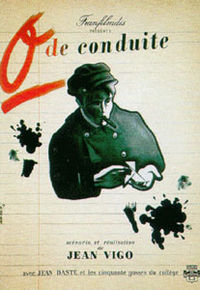
ZERO DE CONDUITE (ZERO FOR CONDUCT)
France, 1933, 60 minutes, Black and white.
Directed by Jean Vigo.
Zero for Conduite is a French classic of 1933. It is a short film and certainly shows in its style that the age of the silent film had not long passed. However, it is a vigorous film with its fantasy and revolutionary overtones. The impact that it made at the time must have been strong and it has some history of being banned. It is invaluable as an example of early sound cinema and French cinema.
What makes the film of great interest now is its influence on Lindsay Anderson's well known if... Anderson (and his screen writer, David Sherwin) have taken the school and society theme of Vigo's film, retaining something of its structure with their chapters, and even with some of the parallel sequences although the headmaster in Vigo's film is stranger than Andersen's since he is a dwarf), Anderson's most interesting film, O Lucky Man! is also indebted to Zero de Conduite. It is interesting to note that t the photography is by Boris Kaufman, responsible for so many later films shot in New York, especially those directed by Sidney Lumet.
1. What are the overtones of the title in schoolboy terms?
2. Why would this film have been of great interest in the thirties when it was made? Why would it have been banned?
3. Though made in the thirties does it seem dated in content? Does this detract from the film?
4. Comment on the use of chapters for illustrating the main points of the story and theme.
5. How realistic was the film? How much fantasy?
6. How ordinary were the boys? With whom could they be identified?
7. Comment on the emotional overtones of the return to school, the sequences in the dormitory, the discipline and control of the master.
8. What was the picture of the staff, from the boys and children's point of view?
9. Comment on the headmaster. Why was he a dwarf? What did this indicate?
10. Why were the three boys picked on all the time? Why did they plot against the staff?
11. Why was it so important for them to plot revolution?
12. Comment on the importance of the ex-students' day and its presentation of the status quo; the types of old boys that were welcomed back to the school; their distinguished careers and established status.
13. What was the significance of the revolt against the staff, the alumni and the revolution from the roofs?
14. What were the main themes of the film - education, discipline, boys and growing up, teachers, institutions and establishment?
15. Was the film too anarchical, or was it a fantasy that raised legitimate points?
16. Technical aspects of communicating themes: loneliness of the train ride and sharing things, boys playing up and punishment, getting up, 'The Creep' and his discipline, Ruguet liking the boys, his limitations, the headmaster as clown, frightening Tabart about homosexuality etc.?